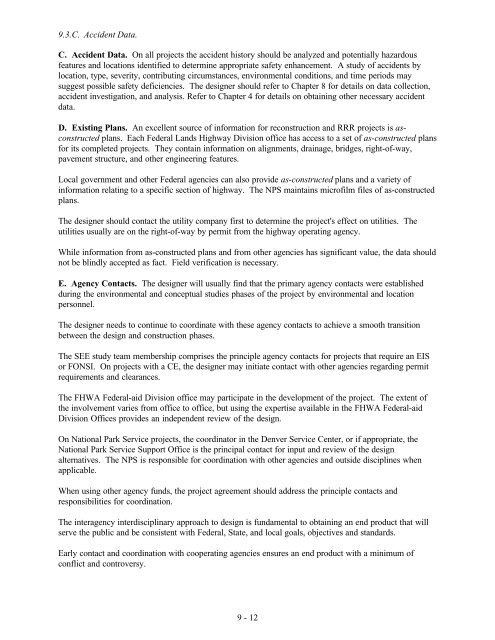FLH PDDM Chapter 9 - Eastern Federal Lands Highway Division
FLH PDDM Chapter 9 - Eastern Federal Lands Highway Division
FLH PDDM Chapter 9 - Eastern Federal Lands Highway Division
Create successful ePaper yourself
Turn your PDF publications into a flip-book with our unique Google optimized e-Paper software.
9.3.C. Accident Data.C. Accident Data. On all projects the accident history should be analyzed and potentially hazardousfeatures and locations identified to determine appropriate safety enhancement. A study of accidents bylocation, type, severity, contributing circumstances, environmental conditions, and time periods maysuggest possible safety deficiencies. The designer should refer to <strong>Chapter</strong> 8 for details on data collection,accident investigation, and analysis. Refer to <strong>Chapter</strong> 4 for details on obtaining other necessary accidentdata.D. Existing Plans. An excellent source of information for reconstruction and RRR projects is asconstructedplans. Each <strong>Federal</strong> <strong>Lands</strong> <strong>Highway</strong> <strong>Division</strong> office has access to a set of as-constructed plansfor its completed projects. They contain information on alignments, drainage, bridges, right-of-way,pavement structure, and other engineering features.Local government and other <strong>Federal</strong> agencies can also provide as-constructed plans and a variety ofinformation relating to a specific section of highway. The NPS maintains microfilm files of as-constructedplans.The designer should contact the utility company first to determine the project's effect on utilities. Theutilities usually are on the right-of-way by permit from the highway operating agency.While information from as-constructed plans and from other agencies has significant value, the data shouldnot be blindly accepted as fact. Field verification is necessary.E. Agency Contacts. The designer will usually find that the primary agency contacts were establishedduring the environmental and conceptual studies phases of the project by environmental and locationpersonnel.The designer needs to continue to coordinate with these agency contacts to achieve a smooth transitionbetween the design and construction phases.The SEE study team membership comprises the principle agency contacts for projects that require an EISor FONSI. On projects with a CE, the designer may initiate contact with other agencies regarding permitrequirements and clearances.The FHWA <strong>Federal</strong>-aid <strong>Division</strong> office may participate in the development of the project. The extent ofthe involvement varies from office to office, but using the expertise available in the FHWA <strong>Federal</strong>-aid<strong>Division</strong> Offices provides an independent review of the design.On National Park Service projects, the coordinator in the Denver Service Center, or if appropriate, theNational Park Service Support Office is the principal contact for input and review of the designalternatives. The NPS is responsible for coordination with other agencies and outside disciplines whenapplicable.When using other agency funds, the project agreement should address the principle contacts andresponsibilities for coordination.The interagency interdisciplinary approach to design is fundamental to obtaining an end product that willserve the public and be consistent with <strong>Federal</strong>, State, and local goals, objectives and standards.Early contact and coordination with cooperating agencies ensures an end product with a minimum ofconflict and controversy.9 - 12
















